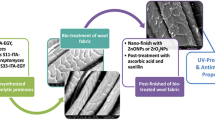Abstract
Greater attention has been given to enzymatic processes of textiles as effective alternatives to conventional chemical treatments because of the non-toxic and eco-friendly characteristics of enzymes as well as the increasingly important requirement for reducing pollution in textile production. A new functionalization method for wool fabrics based on immobilization of lysozymes was investigated in this paper. Wool fabric was first activated with glutaraldehyde, and then employed to covalently immobilize lysozymes. Main immobilization parameters were optimized in terms of the activity of immobilized enzyme. A high activity of the immobilized enzyme was obtained when the fabric was activated at 25 °C for 6 h in a bath containing with 0.2% of glutaraldehyde followed by the immobilization at 4 °C and pH 7.0 for 6 h with 5 g l−1 lysozyme. The scanning electron microscopy and staining tests based on modified Coomassie protein assay (Bradford method) revealed that the lysozyme was fixed covalently on the wool fabric. Wool fabrics immobilizing lysozymes presented a higher ratio of bacteriostasis to Staphylococcus aureus. The durability of antibacterial wool was assessed and the lysozyme immobilized on wool fabric retained ca. 43% of its activity after five cycles of use when taking the activity of the immobilized lysozyme before using as reference.









Similar content being viewed by others
References
Cavaco-Paulo A, Guebitz G (2003) Textile processing with enzymes. Woodhead Publishing, Cambridge, pp 107–130
Chen J, Wang Q, Hua ZZ, Dua GC (2006) Research and application of biotechnology in textile industries in China. Enzyme Microb Tech 40:1651–1655
Schindler WD, Hauser PJ (2004) Chemical finishing of textiles. Woodhead Publishing, Cambridge, pp 165–174
Vigo TL (1983) Protection of textiles from biological attack. In: Lewin M, Sello SB (eds) Handbook of fiber science and technology, Vol. II, Chemical processing of fibers and fabrics, Functional finishes, Part A, Marcel Dekker, New York, pp 367–427
Freedi G, Arai T (2001) Binding of metal cations to chemically modified wool and antimicrobial properties of the wool-metal complexes. J Appl Polym Sci 82:3513–3519
Taddei P, Monti P, Freddi G, Arai T, Tsukada M (2003) Binding of Co(II) and Cu(II) cations to chemically modified wool fibres: an IR investigation. J Mol Struct 650:105–113
Wang SH, Hou WS, Wei LQ, Jia HS, Liu XG, Xu BS (2007) Antibacterial activity of nano-SiO2 antibacterial agent grafted on wool surface. Surf Coat Tech 202:460–465
Ki HY, Kim JH, Kwon SC, Jeong SH (2007) A study on multifunctional wool textiles treated with nano-sized silver. J Mater Sci 42:8020–8024
Gao Y, Cranston R (2008) Recent advances in antimicrobial treatments of textiles. Text Res J 78:60–72
Han SY, Yang YQ (2005) Antimicrobial activity of wool fabric treated with curcumin. Dyes Pigments 64:157–161
Zhu P, Sun G (2004) Antimicrobial finishing of wool fabrics using quaternary ammonium salts. J Appl Polym Sci 93:1037–1041
Purwar R, Joshi M (2004) Recent developments in antimicrobial finishing of textiles—a review. AATCC Rev 4:22–26
Pushpa B (2001) Finishing of textile materials. J Appl Polym Sci 83:631–659
Wikipedia, the free encyclopedia. http://en.wikipedia.org/wiki/Lysozyme. Accessed 1 Oct 2008
Hughey VL, Johnson EA (1987) Antimicrobial activity of lysozyme against bacteria involved in food spoilage and food-borne disease. Appl Environ Microbiol 53:2165–2170
Appendini P, Hotchkiss JH (1997) Immobilization of lysozyme on food contact. Polymers as potential antimicrobial films. Pack Technol Sci 10:271–279
Ibrahim HR, Matsuzaki T, Aoki T (2001) Genetic evidence that antibacterial activity of lysozyme is independent of its catalytic function. FEBS Lett 506:27–32
Zhao YP, Zhang H, Yang YJ (2002) Study on improvement of assaying lysozyme. Food Sci 23:116–119
Wang Q, Li CX, Fan XR, Wang P, Cui L (2008) Immobilization of catalase on cotton fabric oxidized by sodium periodate. Biocat Biotrans 26:437–443
Bradford MM (1976) A rapid and sensitive method for the quantitation of microgram quantities of protein utilizing the principle of protein-dye binding. Anal Biochem 72:248–254
He MZ, Yan J, Gong Y (2005) Anti-bacterial fabric and the evaluation of its property. Shanghai Text Sci Tech 33:62–64
Guo Y (1994) Enzyme engineering. China light industry press, Beijing, pp 109–110
Acknowledgments
This work was financially supported by the National High Technology Research and Development Program of China (2008AA02Z203) and Jiangsu Provincial Undergraduate Innovation Project.
Author information
Authors and Affiliations
Corresponding author
Rights and permissions
About this article
Cite this article
Wang, Q., Fan, X., Hu, Y. et al. Antibacterial functionalization of wool fabric via immobilizing lysozymes. Bioprocess Biosyst Eng 32, 633–639 (2009). https://doi.org/10.1007/s00449-008-0286-5
Received:
Accepted:
Published:
Issue Date:
DOI: https://doi.org/10.1007/s00449-008-0286-5




